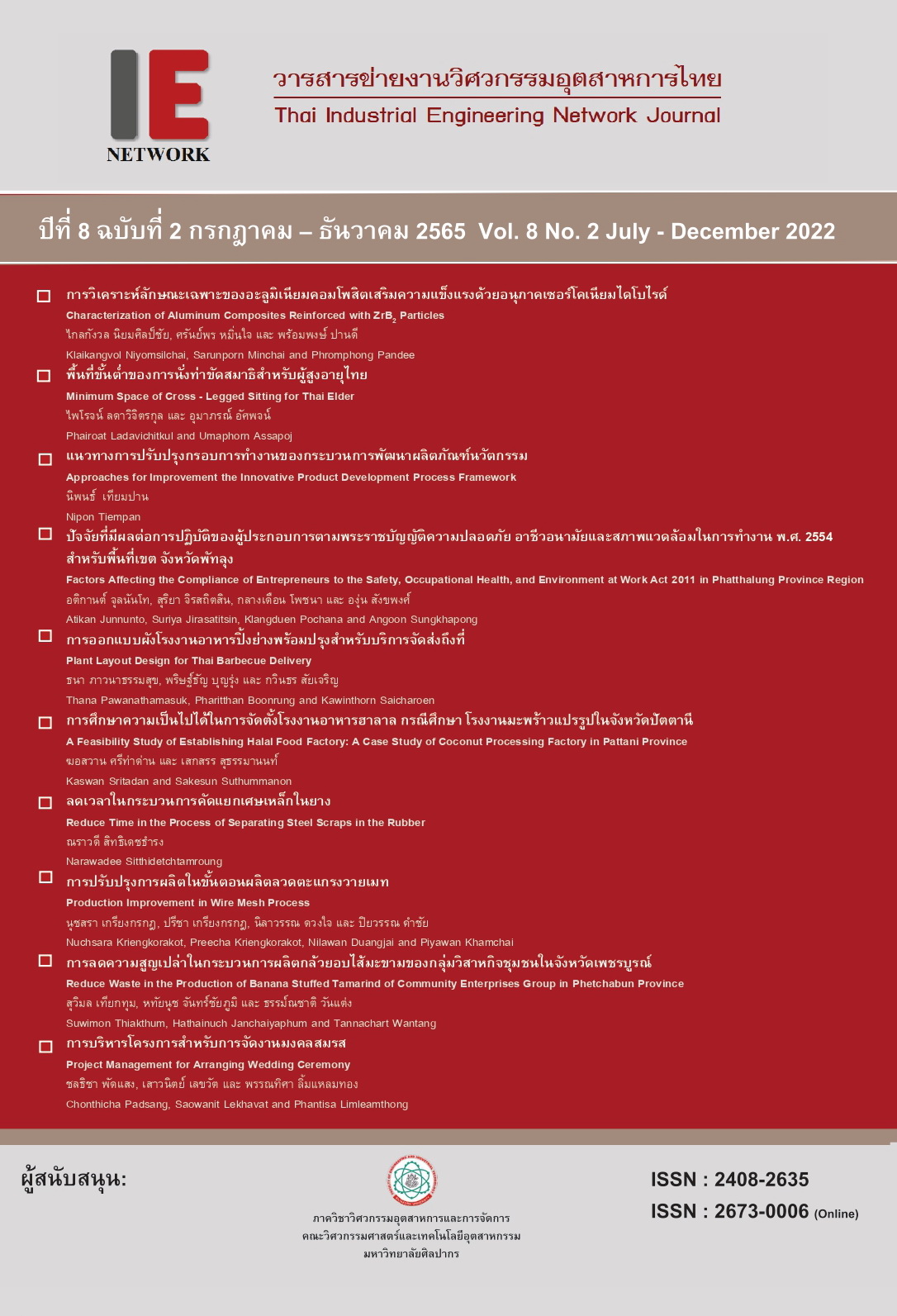Reduce Time in the Process of Separating Steel Scraps in the Rubber
Main Article Content
Abstract
This research aims to reduce the time in the procedure of separating iron separation from rubber. The researcher studied the working process and collected data on the process of separating the scrap iron from the rubber. The working time of 322.21 seconds per 1 cycle of scrap metal sorting from rubber. Therefore, it focuses on reducing the process time based on found that the reason for the delay in the process is that employees must use their hands to spread the rubber to find iron scrap because there is no equipment to help in separating iron scrap. From the aforementioned problems, have come up with a way to make the work process more efficient. By designing and building equipment. After using a device to help separate scrap iron from rubber, it was found that the time to sort scrap iron from the tire 1 cycle was 24.63 seconds from the original time to sort scrap iron from the rubber was 322.21 seconds per 1 cycle, the time can be reduced by 297.58 seconds or 92.36%
Article Details

This work is licensed under a Creative Commons Attribution-NonCommercial-NoDerivatives 4.0 International License.
บทความ ข้อมูล เนื้อหา รูปภาพ ฯลฯ ที่ได้รับการตีพิมพ์ในวารสารฯ ถือเป็นลิขสิทธิ์ของวารสารฯ หากบุคคลหรือหน่วยงานใดต้องการนำทั้งหมดหรือส่วนหนึ่งส่วนใดไปเผยแพร่ต่อหรือเพื่อกระทำการใดๆ จะได้รับอนุญาต แต่ห้ามนำไปใช้เพื่่อประโยชน์ทางธุรกิจ และห้ามดัดแปลง
References
Krungsri Research,แนวโน้มธุรกิจอุตสาหกรรม ปี 2564-2566 อุตสาหกรรมยางพาราแปรรูป, ข้อมูลจากhttps://www.krungsri.com/th/research/industry/industry-outlook/agriculture/rubber/IO/io-rubber-21 (วันที่สืบค้นข้อมูล 15 มิถุนายน 2565)
พงษ์ธร แซ่อุย, บทความเรื่องเทคโนโลยีการรีไซเคิลยาง, หน่วยวิจัยโพลิเมอร์ศูนย์เทคโนโลยีและวัสดุแห่งชาติ, ตุลาคม-ธันวาคม 2555
สถาบันพลาสติกและศูนย์วิจัยและพัฒนา อุตสหกรรมยางไทย 2556, ข้อมูลจาก
https://www.thaiplastics.org/img/content_attachment/attach/plastics_foresight_vol.10_.pdf (วันที่สืบค้นข้อมูล มิถุนายน 2565)
สถาบันการจัดการบรรจุภัณฑ์และรีไซเคิลเพื่อ สิ่งแวดล้อม สภาอุตสาหกรรมแห่งประเทศไทย, ข้อมูลจาก https://thaiplastics.org/img/content_ attachment/attach/plastics_foresight_issue9. pdf. (วันที่สืบค้นข้อมูล 15 มิถุนายน 2564)
รัชต์วรรณ กาญจนปัญญาคม, การศึกษางานอุตสาหกรรม, สำนักพิมพ์ท้อป, 2562
วันชัย ริจิรวนิช, การศึกษาการทำงาน หลักการและกรณ๊ศึกษา, สำนักพิมพ์แห่งจุฬาลงกรณ์มหาวิทยาลัย กรุงเทพฯ พิมพ์ครั้งที่ 8, 2555
Pongchairerks, P. (2013). Benefits and applications of methods engineering. Kasetsart Engineering Journal, 83(26), 84-91.
สุริยัน สังข์สนะ, ศึกษาเวลา Time Study, ข้อมูลจากhttps://goterrestrial.com/2021/02/02/cycle-time/ (วันที่สืบค้นข้อมูล 20 มิถุนายน 2565)
Authayarat, W., & Ariyajunya, B. (2021), The Application of Service Design Thinking and Work Study in Process Improvement of Community Enterprise Manufacture: A Case Study of Granola Bar Production Process, Naresuan University Engineering Journal, Vol.16, No.1, Jan - June 2021, pp.39-52.
ศุภพัฒน์ ปิงตา, การลดเวลาในกระบวนการประกอบปะเก็นโลหะ, วารสารข่ายงานวิศวกรรมอุตสาหการไทย, ปีที่ 7, ฉบับที่ 1 มกราคม-มิถุนายน 2564, หน้า 68-78.
Standards, C. (2017), International Productivity Monitor. OECD Publishing, ข้อมูลจาก https://books.google.fr/books?id=NAot DwAAQBAJ. (วันที่สืบค้นข้อมูล มิถุนายน 2565)
Mazumder, S., Kabir, G., Hasin, M., Ali, S., 2018, Productivity benchmarking using analytic network process (ANP) and data envelopment analysis (DEA). Big Data and Cognitive Computing 2 (3), 27, ข้อมูลจาก https://doi.org/10.3390/bdcc2030027.
Marksberry, Phillip; Parsley, David C. Managing the IE (Industrial Engineering) Mindset: A quantitative investigation of Toyota's practical thinking shared among employees. Journal of Industrial Engineering and Management (JIEM), 2011, 4.4: 771-799.
Srinivasaraghavan, Jayanth; Allada, Venkat. Application of mahalanobis distance as a lean assessment metric. The International Journal of Advanced Manufacturing Technology, 2006, 29.11: 1159-1168.
Scherrer-Rathje, Maike; Boyle, Todd A.; DEFLORIN, Patricia. Lean, take two! Reflections from the second attempt at lean implementation. Business horizons, 2009, 52.1: 79-88.
Mishra, O., & Garg, D. JIT supply chain; an investigation through general system theory. Management Science Letters, 2013, 3.3: 743-752.
ยุทธณรงค์ จงจันทร์, ณฐา คุปตัษเฐียร, การเพิ่มผลผลิตสายการผลิตเตาเหล็กหล่อ กรณีศึกษา: บริษัท เอ็ม เอ็น แมชชีนแอนด์ฟราวน์ดรี้ จำกัด, วารสารวิศวกรรมศาสตร์ ราชมงคลธัญบุรี, ปีที่ 8 ฉบับที่ 2 เดือนกรกฎาคม-ธันวาคม 2553, หน้า 17-27.
พรลภัส เลิศศักดิ์วานิช, ประจวบ กล่อมจิตร, การ ลดเวลาในการปรับตั้งแม่พิมพ์ในกระบวนการอัดขึ้นรูปร้อน, วารสารวิศวกรรมศาสตร์ ราชมงคลธัญบุรี, ปีที่ 18 ฉบับที่ 2 เดือนกรกฎาคม-ธันวาคม 2563, หน้า 47-58.
ธรรมศักดิ์ ค่วยเทศ, ธีรพล เถื่อนแพ และ นิศาชล จันทรานภาสวัสดิ์, การลดความสูญเปล่าในกระบวนการทำงานของอุตสาหกรรมบริการด้านโรงแรมโดยแผนภูมิการไหล, วารสารวิชาการพระจอมเกล้าพระนครเหนือ ปีที่ 31, ฉบับที่ 1 ม.ค.-มี.ค. 2564, หน้า 180-192.
S. Solpin and S. Sookto, Increasing capacity for inbound and outbound operation in Beverage warehouse with handing operations improvement: Case study of beverage distribution firm, Journal of Energy and Environment Technology, vol. 4, no. 1, pp. 51–59, 2018.
วชิระ มีทอง, การออกแบบจิ๊กและฟิกซ์เจอร์, กรุงเทพฯ: สมาคมส่งเสริมเทคโนโลยี (ไทย-ญี่ปุ่น), 2551
สถาบันเหล็กและเหล็กกล้าแห่งประเทศไทย วัสดุที่นำมาใช้ทำอุปกรณ์ช่วย (วัสดุที่เป็นเหล็ก), ข้อมูลจาก https://torwitchukorn.com/th/articles /121043-เกรดและประเภทเหล็ก (วันที่สืบค้น ข้อมูล 28 กุมภาพันธ์ 2564)
K. Niran, วัสดุที่นำมาใช้ทำอุปกรณ์ช่วย (วัสดุที่ เป็นสแตนเลสสตีล), ข้อมูลจาก https://www. reviewsth.com/stainlesssteel/ (วันที่สืบค้นข้อมูล 28 กุมภาพันธ์ 2564)
ฐิติยา สุ่นศรี, วัสดุที่นำมาใช้ทำอุปกรณ์ช่วย (วัสดุที่เป็นแม่เหล็ก), ข้อมูลจาก https://www. youngciety.com/article/journal/magnets- science-for-kid.html (วันที่สืบค้นข้อมูล 28 กุมภาพันธ์ 2564)
J. Anuwat, วัสดุที่นำมาใช้ทำอุปกรณ์ช่วย (วัสดุที่เป็นแม่เหล็ก), ข้อมูลจาก https://www. scimath.org/lesson-physics /item/7320-2017-06-14-16-05-39 (วันที่สืบค้นข้อมูล 28 กุมภาพันธ์ 2564)
Deawjoung, วัสดุที่นำมาใช้ทำอุปกรณ์ช่วย (วัสดุที่เป็นล้ออุตสาหกรรม), ข้อมูลจากhttps://www.tspsupplythai.com/2018/10/02/3/ (วันที่สืบค้นข้อมูล 28 กุมภาพันธ์ 2564)


